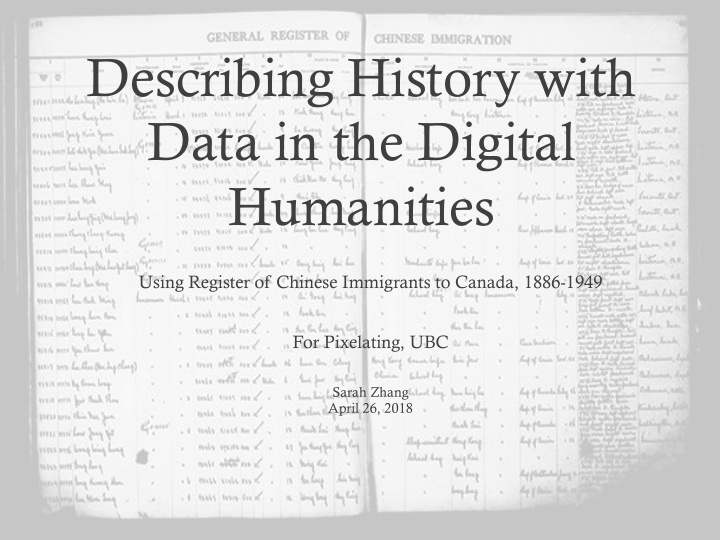



Describing History with Data in the Digital Humanities Using Register of Chinese Immigrants to Canada, 1886-1949 For Pixelating, UBC Sarah Zhang April 26, 2018
Background • The head tax imposed by the Canadian Government on Chinese Immigrants between 1885 to 1923 • The register presents an irony: rich data • Transformation of the print register to a digital spreadsheet, 2005-2007 • Normalization of transliterations of the immigrants’ origins, 2008-2010, led by UBC’s Asian Library The dataset on Open Collection
Normalization of transliteration of origins-The groundwork At level of county: At level of village/town: The normalized village name- 恒美 Source: Chiang, R., 2016 ( code 3793 ) and the corresponding recorded names-codes
Digging at the level of county for immigrants’ wellbeing Source: Ward, 2013 Mean Height by Age, contrasting 5 birth year cohort. (n=11,839) for immigrants from Xinhui
Digging at the level of village/town for migration pattern
Workflow-Producing the visualization of village-destination connection for Zhongshan county, using Palladio • Understanding the data- the challenge posed by the lack of codebook • Data cleaning • Convert the dataset to .csv file • Drag and drop to Palladio • Switch to the tab “Graph”, select a variable for “source” and a variable for “target” • Make the spots weighted • Explore!
Combining with other methods: aggregated statistical and data visualization
Conclusion • Normalization of village/town names is valuable- allows research at all level of granularity. • More nuanced trends in the immigrants’ wellbeing and migration patterns uncovered. • This is just beginning …
Reference Chiang , R. ( 2016). Canada Immigration Chinese Head Tax Record Sun Woy District. ISSCO 2016: 9th International Conference of the International Society for the Study of Chinese Overseas Ward, W . P. (2013;2012). Stature, migration and human welfare in south china, 1850-1930. Economics and Human Biology, 11 (4), 488. doi:10.1016/j.ehb.2012.10.003 Yu, H., Chan, S. (2017). The Cantonese Pacific: Migration Networks and Mobility Across Space and Time. In Wong, L. L. (ed.). Trans-pacific mobilities: The chinese and canada . Vancouver;Toronto;: UBC Press.
Let’s play with Palladio! • http://hdlab.stanford.edu/palladio/ • Download the sample data:
Steps • Click “Start” • Copy and paste your data, or upload a .csv file • Edit attributes • Open the Graph tool • Specify source and target nodes • Size nodes, highlight nodes • Add a filter • Try two-mode network: choose a temporal variable for source
Want to learn more about Palladio? From Hermeneutics to Data to Networks: Data Extraction and Network Visualization of Historical Sources By Marten Düring

Recommend
More recommend